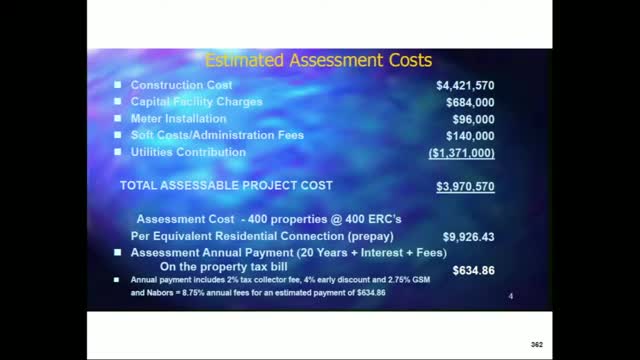Martin County Utilities approves $5.3M water project after decade-long community effort
December 14, 2024 | Martin County, Florida
This article was created by AI summarizing key points discussed. AI makes mistakes, so for full details and context, please refer to the video of the full meeting. Please report any errors so we can fix them. Report an error »

Martin County residents are set to see significant improvements in their water services following the Martin County Board of Commissioners' unanimous approval of a final assessment resolution during their December 10, 2024, meeting. This decision will facilitate the construction of a new water project that will serve 400 properties, marking a major milestone in a decade-long effort to enhance water access in the community.
The total project cost is estimated at $5,341,570, with the Martin County Utilities Department contributing $1,371,000. This contribution reduces the assessable cost to approximately $3 million, resulting in an estimated prepayment amount of $9,926.43 per connection. Homeowners can expect an annual payment of about $634.86, amortized over 20 years at a rate of 1.52%, plus interest and standard fees. Currently, Martin County Utilities serves around 36,700 water customers, with average residential consumption at about 6,000 gallons per month.
Construction is anticipated to begin in February 2025, with property owners expected to start making payments by August 1, 2025. Any unpaid amounts will appear on the annual tax bill in November 2025.
Commissioner Campy praised the efforts of both the staff and the residents who have been involved in this lengthy process. He highlighted the challenges faced, including previous failed ballot measures and the need for policy changes to ensure a fair assessment process. The project has been in the works for over ten years, with residents actively participating in discussions and advocating for water service improvements.
The board's decision not only addresses immediate water service needs but also sets a precedent for future utility projects in the area. The successful collaboration between the county and residents demonstrates a commitment to enhancing community infrastructure and ensuring access to essential services. As the project moves forward, it is expected to bring long-term benefits to the neighborhoods involved, paving the way for further developments in the region.
The total project cost is estimated at $5,341,570, with the Martin County Utilities Department contributing $1,371,000. This contribution reduces the assessable cost to approximately $3 million, resulting in an estimated prepayment amount of $9,926.43 per connection. Homeowners can expect an annual payment of about $634.86, amortized over 20 years at a rate of 1.52%, plus interest and standard fees. Currently, Martin County Utilities serves around 36,700 water customers, with average residential consumption at about 6,000 gallons per month.
Construction is anticipated to begin in February 2025, with property owners expected to start making payments by August 1, 2025. Any unpaid amounts will appear on the annual tax bill in November 2025.
Commissioner Campy praised the efforts of both the staff and the residents who have been involved in this lengthy process. He highlighted the challenges faced, including previous failed ballot measures and the need for policy changes to ensure a fair assessment process. The project has been in the works for over ten years, with residents actively participating in discussions and advocating for water service improvements.
The board's decision not only addresses immediate water service needs but also sets a precedent for future utility projects in the area. The successful collaboration between the county and residents demonstrates a commitment to enhancing community infrastructure and ensuring access to essential services. As the project moves forward, it is expected to bring long-term benefits to the neighborhoods involved, paving the way for further developments in the region.
View full meeting
This article is based on a recent meeting—watch the full video and explore the complete transcript for deeper insights into the discussion.
View full meeting